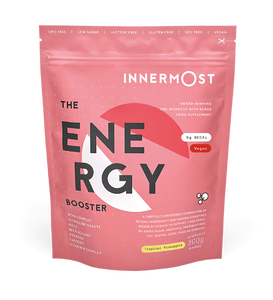We live in a world with alternating seasons, and Britain especially is subject to sometimes extreme changes throughout the year. From the sprouting flowers in the spring, the scorching heat of the summer, and the orange glow of autumn…all the way to the icy and bleak winter – adapting to these different seasons can be difficult for most.
This is where Seasonal Affective Disorder or otherwise known as 'SAD' comes in. You may be all too familiar with this seasonal form of depression, or maybe you have never heard of it before. Either way, we're here to explain what SAD really is, and how to manage it, as well as providing that extra bit of help with advice from our nutritionist Eleanor Thrupp. We’re just here sprinkling a little bit of hope on these dark winter days…
What is SAD?
To gain a greater understanding, let’s first explain what Seasonal Affective Disorder actually is. As a general explanation, SAD is a type of depression that is triggered by a change in the seasons, commonly started by the switch from summer to autumn. This usually gets progressively worse as the days get colder and the daylight hours a fewer from the end of autumn throughout winter.
We're sure you know the feeling – waking up for work when it’s dark, and then driving back home when it’s also dark. Our beloved days are pretty much spent in darkness, and one blurs into the other. This can easily take a toll on anyone - and many it does! It is said that this seasonal disorder affects around 2 million people in the UK, with around 1 in 15 people reported to suffer from it in the months between September and April. In terms of age, SAD is most common during adulthood in people over the age of 20, but it can occur in children too.
Now we know we have talked a lot about winter, but SAD can also be experienced during the summer months, although this is not frequent. This means that the warmer, bright days that most of us rejoice in could instead cause someone else to become stressed and upset. No matter which seasons the disorder is present in, there are shared symptoms that arise which therefore make it difficult to perform day-to-day activities and these include:
- A loss of interest or pleasure in normal daily activities
- A persistent low mood
- Easily irritable
- Anxiety
- Feelings of despair and guilt
- Tired and low energy
- Difficulty concentrating
- Craving carbohydrates and in return gaining weight – mainly winter SAD
- Loss of appetite and skipping meals – common in summer SAD
- Oversleeping and not wanting to get out of bed in the morning
- Or not being able to sleep – The Relax Capsules should help!
- In the worst-case scenario – having thoughts of not wanting to live
How to manage Seasonal Affective Disorder?
Luckily, for those who suffer from SAD, there are 3 main treatments available to reduce the symptoms, and these include light therapy (also known as phototherapy) – exposing the patient to bright light, Psychotherapy – talking therapy, and the option to take medications like anti-depressants. However, these may not be to everyone’s liking, and other lifestyle changes and remedies can be implemented to help with the affective disorder instead or on top of – take note that these mainly apply to winter SAD.
- Make your surroundings sunnier and brighter
Make sure that one of the first jobs on your to-do list is to open your curtains and blinds and ensure that nothing is blocking the natural sunlight from coming through. Ensure that throughout the day you are sitting next to bright windows and getting enough light whilst for example either working from home or in the office – it is all about getting enough of that vitamin D right?
- Take time to go outside and gain fresh air
In the winter is easy to fall into the trap of staying cooped up inside, but partaking in long walks, or even that quick lunch break walk from work is beneficial. When you have some spare time, make sure you get outside during the daylight hours as much as possible – you could even take your lunch outside and sit on a bench with your work bestie. There are so many health benefits to the great outdoors and we can assure you that doing this one small step…or leap into the outside world will be a light in this gloomy winter season.
- Exercise regularly
Again, spending the hours you are not at work cuddled up under a blanket is oh so tempting, but it is proven that physical activity helps relieve both anxiety and stress, and can make you feel better about yourself too which in return can be a mood booster. Exercise and mood work hand in hand with each other. So instead of reaching for that remote control, reach for that gym bag instead. Or if going to the gym is not the one, maybe take up running outside instead? Just make sure you wrap up warm first. The benefits of running are endless!
- Normalise sleep patterns
You need to make sure your sleeping patterns are normalised, and this means setting reliable times to wake up and go to bed – which is easier said than done we know. Morning routines are difficult and getting out of bed and feeling energised first thing in the morning seems near impossible. So, we suggest setting an alarm but keeping it out of arms reach so you must physically get up and turn it off – this should wake you up in the process.
- Spend time with the people you love
This last one is particularly important and for those who have SAD, many isolate themselves from other people and get caught in the 4 walls of their home. To combat your depression, contact your friends or your family and schedule weekly catch-ups like going to a local coffee shop for coffee, or spending one day of the weekend going to the shops together. Doing activities with other people will help you keep your mind off it and make you happier in return. Allow the company of others to bring back that sunshine.
Introducing Eleanor Thrupp
We haven’t spoken a lot about nutrition in this article, but in fact, maintaining a healthy diet can also ease symptoms too. We sat down with our Innermost nutritionist Eleanor Thrupp (Dip-NT, mBANT, CNHC, ANP) to give you an exclusive interview on how you can combat SAD with the food you consume…
Can nutrition be used to ease the symptoms of SAD?
Yes, nutrition can definitely be used to ease symptoms of SAD and is most effective alongside supplementing with vitamin D and getting outside into natural daylight as much as possible.
Low vitamin D is linked to low mood, and it is recommended that most people supplement with it during the winter months. I always recommend choosing a supplement that contains vitamin D in the form of D3 (cholecalciferol) as this is the form that is naturally produced in the skin in response to daylight. Exercise is a well-known natural antidepressant, and you can enhance these effects by exercising outdoors to maximise your exposure to daylight.
If so, what changes/additions should be made to your diet?
It's common to crave sugary carbohydrates when feeling low/depressed, however, it is best to avoid these foods. Instead, focus on a diet that is rich in wholegrains, healthy fats (found in nuts, seeds, oily fish, avocado), and plenty of protein such as lean meat, fish, nuts, beans, chickpeas, and lentils. Our body makes feel-good neurotransmitters such as serotonin from protein foods - so ensuring protein is incorporated into your diet is essential if you’re feeling low.
It is also important to increase the consumption of omega-3 in the diet. EPA and DHA are important omega-3 fats that are often missing from Western diets. They can be found in oily fish (mackerel, salmon, cod liver oil), flaxseeds, chia seeds, walnuts, and soybeans.
Magnesium is a vital nutrient that helps balance mood and increase energy production. It can be found in foods such as dark chocolate (70% or higher), avocados, brazil nuts, wholegrains and green leafy vegetables (kale, spinach).
Are there any specific Innermost products that would work for easing SAD?
The Energy Booster contains maca and caffeine to give an energy boost and vitamin B complex helps fight fatigue. The Focus Capsules contain nootropic and adaptogenic ingredients including Siberian Ginseng and Rhodiola Rosea to reduce mental and physical fatigue.
To learn more from Eleanor and get personalised recommendations based on your goals, you can book a 15-minute or 45-minute consultation with her here.
Summary
Living and dealing with seasonal affective disorder is not easy, and if you are one of the 2 million people each year that suffers from this kind of depression, there is always help out there if that is with treatment plans, home remedies, or a switch up of diet – no one needs to suffer in silence. If you or someone you know has SAD, never be afraid to seek help and contact a GP. There are always brighter days ahead…so keep your chin up and focus on the positives - find those little moments of happiness in the everyday mundane life. Better days are coming.























